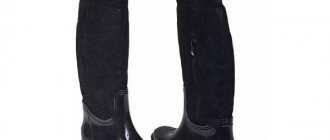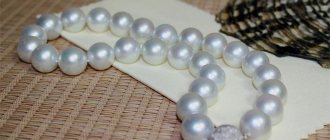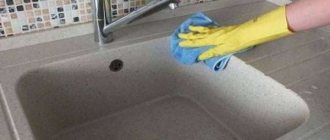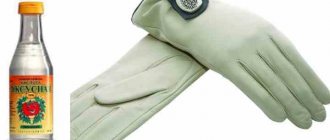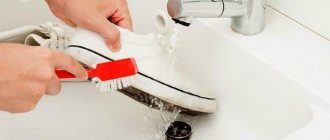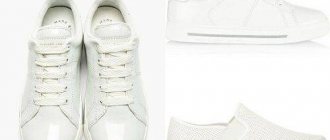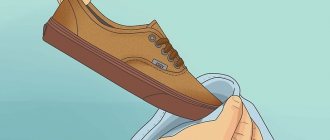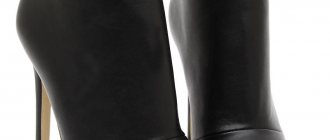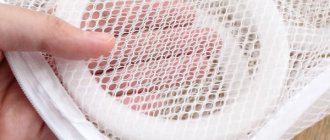What affects the service life
Orthopedic insoles, even with proper care, should be changed once every six months. Manufacturers of this type of device do not recommend wearing them for longer, since they will no longer be useful.
The service life is affected by proper care of orthopedic devices, as well as many other factors.
How quickly the product wears out depends on the person’s physical activity. If a woman wears shoes only to shops and on visits, the service life of course increases.
If boots with orthopedic insoles are used for hiking in the forest, traveling or playing sports, they will last less.
It also affects not only the intensity of wear, but also the weight of the patient.
The frame base does not deform and retains its functionality after six months. Insoles have to be changed due to wear and tear on the insoles and corrective elements.
Disinfection of insoles
Medical alcohol, vinegar, potassium permanganate or hydrogen peroxide can help disinfect insoles. Such compositions will kill unpleasant odors, eliminate dirt, bacteria and stains.
To scrub and disinfect linings, mix the selected product with half and half water and pour into a spray bottle. Spray the solution evenly on each side of the insole and wipe with a damp cloth. After treatment, wipe the product with a clean damp cloth and leave to dry.
You can also use baking soda to disinfect and eliminate bad odor bacteria. However, it will not remove stains and dirt like alcohol. This method is suitable for clean or lightly soiled insoles with an unpleasant odor. To clean, take a bag and fill it with baking soda. Place dry insoles inside, close the bag and shake.
Leave the bag with baking soda and insoles for six to ten hours, then take out the shoe inserts, shake the soda and leave for ten minutes. After this, you can wash it with a damp cloth and leave it to dry, or you can use it immediately and put it in your shoes without washing.
Rules
Caring for an orthopedic device is simple. It is enough to follow the wearing rules and clean regularly.
You can ask your doctor or the pharmacy where you buy the product about everything you need.
Follow these rules and your insoles will last longer than usual:
- Such devices should always be worn with socks to prevent excessive sweating, which could damage the device. If your feet sweat a lot, cleaning will be done more often, which is not very advisable for therapeutic shoes.
- If there are open sores, be sure to use antibacterial soap when washing the insoles and change your socks frequently.
- Insert orthopedic products into shoes only after they are completely dry.
- Wash as little as possible. Try to simply clean the insoles.
- Drying is carried out exclusively at room temperature. It is prohibited to place the product on radiators or other heating devices, as this may lead to deformation. You cannot use a hairdryer for drying.
- If insoles are purchased separately, you can move them from one shoe to another shoe. But the shoe size and heel must match.
- At the end of the day, it is recommended to remove the products from the shoes and dry them.
- If you purchased a Leather-coated device, do not use it with light-colored shoes. These shoes get stained quickly.
With proper care, you can extend the life of your orthopedic insoles. When wearing it, a person should not feel discomfort; if this happens, most likely you did something wrong.
Features of the care and operation of orthopedic insoles
11.02.2021
111
237
Life is so structured that at a certain point in time the idea of comfort and convenience changes, and with it the understanding of beauty changes. The narrow toes of men's shoes, the high heels of elegant sandals and dress shoes, the platform and the original shape of the sole - all this is reviewed, reevaluated, remeasured from the only correct point of view - the health of our feet.
It is this aspect – healthy legs
– should be the main one in the chain of the process of purchasing orthopedic insoles.
Pharmacists, who do not ignore a single article on the farmedinstvo.info
, of course know
why
orthopedic insoles are needed, what
types of
orthopedic insoles are presented in modern pharmacies, and
how to choose
them correctly. In this article, we will share with you, colleagues, useful information about the proper care of orthopedic insoles and tell you what buyers should pay attention to when selling them orthopedic insoles.
Typically, caring for orthopedic insoles does not cause any difficulties. Products with a textile top are washed by hand in warm soapy water, leather ones are wiped with a damp cloth or a piece of soft cloth soaked in a diluted alcohol solution. There are insoles that can be washed in a washing machine.
Dry the insoles at room temperature away from heating devices and direct sunlight. At the end of the day, orthopedic inserts must be removed from the shoes for airing.
The buyer must understand that orthotics are intended for daily wear.
, their service life ranges from several months to several years. This is why insoles should:
- have strength, wear resistance
- be easy to care for and do not shrink when dried
- be hypoallergenic
- let air through
- absorb excess moisture
- have antiseptic properties.
Please pay attention to buyers that orthopedic insoles should be selected
based on lifestyle, preferred type of shoes, heel height, as well as mandatory consideration of the general condition of the feet and the musculoskeletal system as a whole.
Important to consider
that orthopedic insoles are chosen not by shoe size, but by foot size, since the design of the insole must clearly coincide with the anatomy of the foot. When choosing, it is better to immediately try out the product by putting it in your shoes. The insole should be well placed so that the foot does not squeeze or fall out; for this it is important to choose the correct thickness and design of the orthosis. Orthopedic insoles and semi-insoles for a child should be purchased only as prescribed by an orthopedic doctor.
During operation
When using orthopedic insoles, the following points must be taken into account:
- Typically, orthotics do not require special shoes.
But if the insole is thick, then you may need shoes, sneakers, shoes or boots a size larger, because the orthopedic insert will take up part of the inner space of the shoe. The most important thing is that after you insert it into your shoe, it is comfortable for your foot, there is no compression and lack of freedom of movement. If you wear or are just going to wear insoles, then when you buy a new pair of shoes, you need to take them with you to the store and insert them into the shoes before trying them on.
- Orthopedic insoles begin to be worn gradually
. A period of smooth adaptation is necessary to avoid discomfort in the feet and legs. It’s easier to get used to thin leather, gel or silicone earbuds, but more difficult to get used to products with a rigid frame, arch support, pronounced bending and bulges.
- In the first days, it is recommended to wear insoles for 3–4 hours, gradually increasing the time interval until the feet get used to the effect of the orthopedic correction. The adaptation period takes up to two weeks
. If discomfort continues after this time, you should inform your orthopedist.
If you see the buyer’s doubts, try to carefully explain to him that people over 45 years old should wear orthopedic insoles not only for treatment, but also for prevention,
regardless of the presence of foot diseases. Alas, according to recent studies, there are practically no healthy feet. Not all of us have been wearing orthopedic shoes since childhood, doing exercise therapy, walking barefoot and leading an active lifestyle. Very often, by the age of 30, the range of diseases includes degenerative changes in the joints, spine, and inflammatory diseases such as arthritis, bursitis, and synovitis.
The therapeutic and preventive arsenal of orthopedists includes frameless insoles that support the arches of the feet, replenish the shock-absorbing function lost with age, absorb shock loads when walking and playing sports - when used, the joints and spine are protected from excessive load. Foot orthoses help the muscle-venous pump work properly, which leads to a reduction in venous edema of the lower extremities and heaviness in the legs at the end of the working day. also reduce headaches,
since the shock wave is extinguished at the very beginning of the step, and this in turn leads to good health and mood.
Smell
You don't have to wash it to remove the smell. You can clean it with many available means, without using a washing machine.
Untie the laces, widen the sides of the sneakers and carefully remove the insoles.
To remove the unpleasant aroma of sweat, use the following methods:
- Sprinkle the product with baking soda. Leave in this state for 8–12 hours. Baking soda perfectly absorbs odors without harming the structure. Remove the residue with a dry cloth, and you can vacuum the insoles. The soles of sneakers can be treated in the same way to get rid of the stink.
- Place tea bags inside your shoes. Leave them overnight. In the morning, simply remove the bags and enjoy the pleasant aroma.
- Orthotics should not be washed too often, but you can put wet wipes inside to remove odors.
Removing an unpleasant stench is not difficult, but it is still better to prevent its occurrence.
How to prevent odor from insoles?
There are several rules about this:
- wash your feet more often;
- wear only leather shoes or other, but well-breathable ones;
- wear cotton socks and change them 2 times a day;
- use talc on shoes and feet;
- Get pedicures more often.
Caring for orthotics is simple and easy, but you should also take proper care of your feet. After all, excess moisture quickly leads to damage to products.
How to insert orthopedic insoles correctly?
The orthopedic insole is inserted as deep as possible into the toe part of the shoe. In this case, the heel should rest against the heel. Insoles that are too long can be cut with scissors, but no more than 3-5 mm (and only if this does not contradict the instructions).
Many orthopedic insoles have an adhesive applicator, which is used to secure the orthoses into the shoes. Even if there is no such element, a correctly selected insole does not shift along the length.
If you order custom orthopedic insoles from a specialized workshop, a specialist will install them the first time. He will show you how to do it correctly. Ready-made insoles not purchased at an orthopedic salon are installed according to the instructions.
Cleaning
Cleaning shoes and orthotics is a better option than washing them. Wearing clean shoes is much more pleasant than putting dirty shoes on clean feet.
How to clean insoles by hand:
- If the orthopedic product is very dirty, use a soap solution. Pour warm water and a little detergent into a basin. Take a sponge and gently clean the device. Many orthotics are heat sensitive, and you may accidentally change the shape of the insole if you clean them in cold water.
- Leather orthopedic products can be cleaned with hydrogen peroxide. If you are concerned about the appearance of the products, take a cotton pad, apply some peroxide to it and wipe the surface. This method will not only remove dirt, but also disinfect. Similar to hydrogen peroxide, you can use a solution of potassium permanganate.
- The last cleaning method is to use special foam for shoes. It is applied according to the instructions, and after two minutes it is removed.
After cleaning, medical devices must be dried. Lay a pair of insoles on a flat surface and leave them in the room to dry. The room should be well ventilated.
How to clean
So how do you properly keep your orthotics clean? It all depends on the material from which they are made:
- The leather insole is instantly deformed by machine washing. To disinfect such products and remove dirt, use a soft cloth and a weak alcohol solution. Another cleaning and disinfectant is hydrogen peroxide. Let’s assume an option with a slightly pink solution of potassium permanganate.
- Felt and suede insoles can be gently wiped with soapy water. Use soft sponges and brushes.
- Never use boiling water or completely immerse the product in water! The use of chlorine-based bleaches is prohibited.
- Wash soft insoles from sneakers, such as Ecco, in a machine on a delicate cycle. Water temperature - up to 30 degrees. Spin - at minimum speed, or without spin at all.
- There are special cleaning foams for insoles and shoes. Apply them and remove them after the time specified in the instructions.
We recommend: How to properly wash woolen items?
Rules for caring for silicone insoles “Shol”:
- They are washed in warm (not hot!) soapy water.
- Do not use chlorine-containing products.
- After washing, the insoles are blotted using hygroscopic fabric.
- Drying is carried out naturally, without batteries, hair dryers and sun.
How to wash the sole
The cleanliness of sneakers depends on the quality of the polyurethane on sports models. Poor quality material gets dirty faster, especially in industrial cities, the sole becomes gray-yellow in color.
12 ways to return whiteness:
- Rub with a stationery eraser. Rub dirty areas with strong pressure. When soiled, the top layer of the eraser is cut off with a utility knife.
- Dilute bleach with water in a ratio of 1:2. Wearing gloves and armed with a rag, vigorously rub the sole. Rinse with clean water and dry.
- Use a melamine sponge. The innovative product can cope with any contamination. Moisten the sponge with water and press it with your palms to remove excess moisture. Rub the sole with the tip.
- Tooth powder and toothpaste are excellent whiteners. Do not use with abrasive particles, the material will be scratched. Wet the sole, apply the product, and rub. Leave for 10 minutes, rub thoroughly again with a toothbrush and rinse.
- Nail polish remover will return the sole to its former whiteness. Soak a soft cloth with acetone and wipe dirty areas. Wash the sole well under running water.
- Citric acid is applied with a damp brush. Rub and wash off. Repeat until the desired result is obtained. An alternative to citric acid is vinegar essence.
The final result depends on how often you clean the sole and how quickly you remove stains. It is better to use an old toothbrush; its bristles are thicker and penetrate into all hard-to-reach places.
Whitening sneakers
Elimination of unpleasant odor
In order not to feel discomfort, it is important to know what products to use so that the inside of your shoes does not stink. Persistent odor is the cause of increased sweating, improper care of sneakers or lack of a breathable base.
If the problem is not solved, you will have to remove unpleasant odors every time.
- Use tea bags. Place under the insoles at night. The smell of tea will overcome the terrifying aroma.
- Place the baking soda in a cotton bag and leave overnight. You can sprinkle it on the insoles and remove the residue with a vacuum cleaner in the morning.
- To prevent them from stinking, they buy chlorhexidine. Dilute 3 tbsp. l. in 200 ml of water. Wipe the internal surfaces with the solution and leave to dry. No need to wash.
- Activated carbon will save you from cat urine. Remove the tablets from the plate and place them on the insoles. After 5 hours, the moisture will be absorbed along with the source of the stench.
- Make a solution of potassium permanganate. 6–8 crystals per liter of water. Treat the inner surfaces of the shoes with a light pink solution.
- Silica gel will remove the smell of cat urine. Fill the sneakers to the top and leave for a day. It remains to dry.
- In winter, in frosty weather, take your shoes out onto the balcony. In the morning the smell will not be as strong.
- Dry with an ionizer. Ultraviolet treatment with an ionizer eliminates any bacteria and their waste products, and, accordingly, eliminates the smell.
- A bleach solution perfectly removes stench. Pour into shoes for a couple of minutes, pour out and dry.
- A cotton swab soaked in medical alcohol is used to treat the inner walls of the shoes. Do not wash.
To remove unpleasant odors, special sprays are purchased. Sold in every shoe store. Sprays contain antithetical and antifungal substances and do not harm the material.
How to wash laces
